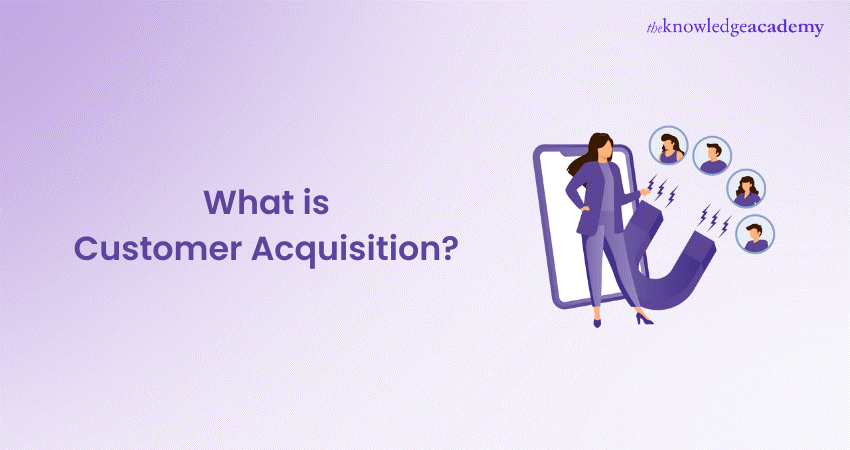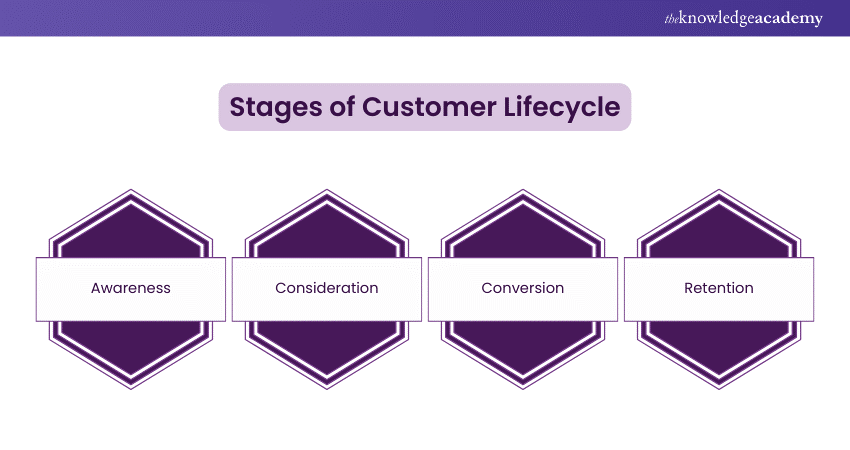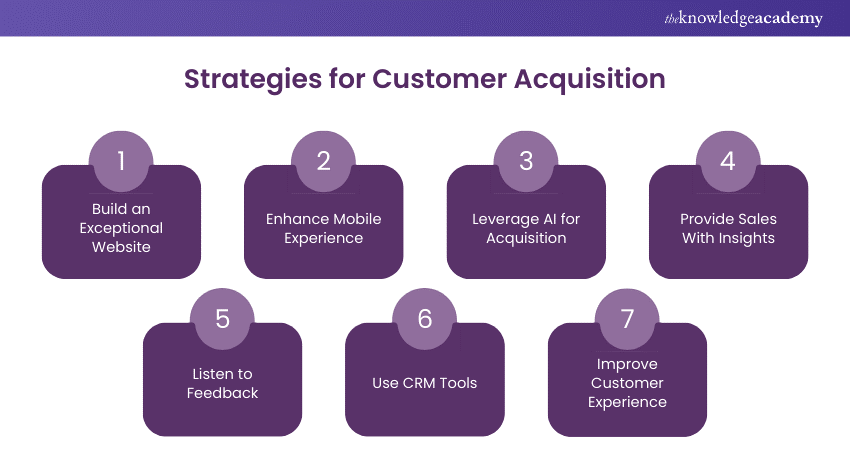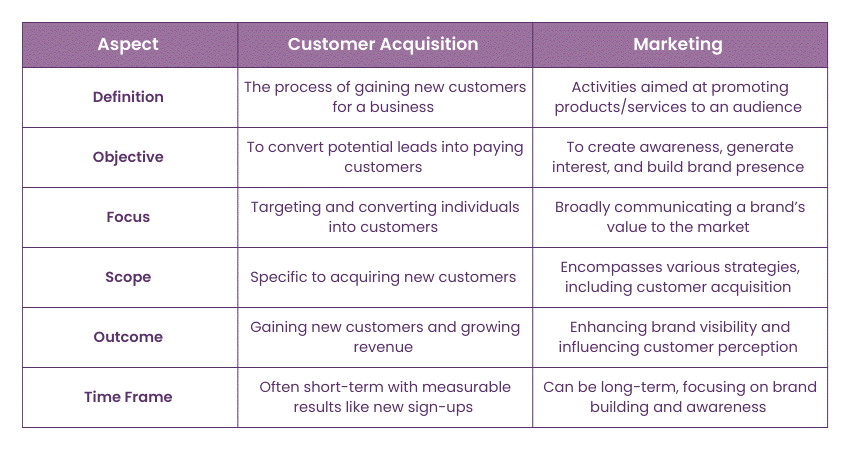We may not have the course you’re looking for. If you enquire or give us a call on + 1-866 272 8822 and speak to our training experts, we may still be able to help with your training requirements.
Training Outcomes Within Your Budget!
We ensure quality, budget-alignment, and timely delivery by our expert instructors.

Can you guess the most valuable asset of a company? No, it's not the product or the service; it's the customers. Customers are the ones that bring life to a business and make it survive. However, most businesses decline after three years of commencement as they fail to acquire new customers. If you are one among them, then don’t worry. In this blog, we’ll discuss Customer Acquisition and some useful strategies for building a successful Customer Acquisition strategy for your business.
Table of Contents
1) What is Customer Acquisition?
2) Importance of Customer Acquisition
3) Customer Acquisition Purpose
4) Strategies for Customer Acquisition
5) Examples Customer Acquisition
6) Customer Acquisition Challenges and Solutions
7) Differences Between Customer Acquisition and Marketing
8) Conclusion
What is Customer Acquisition?
Customer Acquisition is the backbone for any business, as it deals with attracting new customers and converting them into paying clients. The influx of new customers contributes to business growth and sustainability. Without it, business may collapse. Since it's an ongoing effort, companies need to find new ways to interact with their potential customers.
Customer Acquisition and the Customer Lifecycle
The lifecycle of a customer consists of four key stages:

a) Awareness: In this stage, customers learn about your business and products or services
b) Consideration: Customers assess whether your offerings meet their demands or not
c) Conversion: Then, the customer decides about purchasing your products or services
d) Retention: In the final stage, businesses emphasise keeping the customers to do repeated business
An effective Customer Acquisition is vital for guiding your prospects through these stages, ultimately fostering loyalty.
Importance of Customer Acquisition
Acquiring customers is essential for businesses of any size and age. It allows your business to:
a) Produce income to finance expenses, compensate workers, and invest in expansion.
b) Show evidence of progress to outside parties such as investors, collaborators, and thought leaders.
Consistently drawing in and persuading new customers helps businesses stay strong, keep expanding, and satisfy investors.
Customer Acquisition Purpose
The objective of Customer Acquisition is to develop a reliable and organised method for drawing customers to your company. Counting on customers to organically discover your business does not ensure consistent or higher profits in the long run.
Customer Acquisition experts use methods to motivate possible customers to act. This procedure seeks to develop a long-lasting plan for gaining new clients and increasing company profits.
Although this process may appear akin to marketing, there is a difference. Marketing concentrates on developing brand recognition, while Customer Acquisition revolves around prompting action and transforming potential leads into actual customers.
Optimise your conversions with our Conversion Rate Optimisation Training – Register now!
Strategies for Customer Acquisition
To acquire new customers, you need a high-level business strategy. Here are seven Customer Acquisition strategies:

1) Build an Outstanding Website
A visually appealing website is one of the most successful methods to gain customers. Among all the available websites, they opted to click on yours. Now that their attention is captured, they should gainsome beneficial insights.
In this period of short attention span of an average netizen, having a solid online presence is no longer a choice.
2) Enhance Your Mobile User Experience
A seamless mobile journey is a vital aspect of the digital environment and necessary for drawing in customers. Using mobile devices for internet browsing is no longer just an “on-the-go” activity; it has become a common activity during daily routines like enjoying coffee in the morning, relaxing on the couch with Netflix, or unwinding in bed.
This change offers many chances to interact with clients, but it necessitates a mobile site that is responsive and customer focused. This implies not focusing on promoting sales, but instead being transparent, truthful, and supportive.
Making it simple for potential customers to contact a sales representative, sign up for a free trial, request a demo, or seek assistance from customer service when faced with problems.
3) Leverage AI for Proactive Customer Acquisition
Businesses that plan ahead utilise a proactive approach to acquiring customers, and with the help of AI, this becomes an easy and affordable process. A chatbot can welcome visitors to your website or app and smoothly direct them to sales or support in case they require help or have any inquiries. Even though it may appear insignificant, a basic popup message assuring potential customers of available help can have a considerable effect.
4) Provide Sales Teams with Access to Customer Insights
Customer information is an essential part of the communication cycle, including data from customer service, sales, and other sources. At present, businesses can utilise customer data and analytics to gain insights instead of relying on speculation about customer preferences. This information impacts the development of products, communication tactics with potential clients, and other aspects.
Having access to this data would allow sales teams to have a deeper understanding of customer needs and customise their sales pitches accordingly.
Furthermore, having access to customer data is important for everyone in a company, not just for sales purposes. Businesses focused on their customers utilise information on areas of dissatisfaction to make enhancements.
5) Pay Attention to Customer Feedback
Market research may not always be reliable, as customer tastes and preferences are always changing. It is important to truly pay attention to customer feedback, regardless of whether it is provided purposely or not.
Numerous businesses make mistake by promoting products or services they believe people desire. When these items fail to be purchased, they are left pondering the reasons behind the unsold inventory or unsuccessful sales pitches. The important thing is to take decisions on the customer's needs by actively paying attention to their feedback. This includes examining survey answers and feedback, working with your support team on customer complaints, and keeping track of conversations on social media and online forums.
It is crucial to understand that feedback can also come from customers who are not existing customers. Potential clients and leads often discuss their interactions with a business. Businesses must pay attention to these discussions and actively listen no matter where they take place. Neglecting a negative news report or popular social media post may give the impression that a salesperson is not in tune with current events; therefore, being well-informed is essential for successful Customer Acquisition.
6) Utilise CRM Tools
A Customer Relationship Management (CRM) tool can improve the process of acquiring prospects by handling leads. It can even automate marketing campaigns by providing key customer behaviour insights.
Integrating it with other tools can help in making a unified plan and analyse feedback. This boosts the effectiveness of Customer Acquisition.
7) Focus on Improving the Customer Experience
The purchasing decisions and customer acquisition are greatly influenced by customer experience. A Zendesk Survey found that 62% of B2B customers and 42% of B2C customers boosted their buying habits following a satisfactory customer service experience.
On the other hand, 66% of B2B and 52% of B2C customers stopped purchasing following a negative encounter. Because customer service is frequently the initial direct interaction potential customers experience with your brand, it is important to ensure it is memorable.
Studies also suggest that emotions play a significant role in determining buying choices. Customer support is essential in forming emotional connections as the face of your brand.
Learn effective Content Marketing techniques with our Content Marketing Course – Sign up now!
Examples Customer Acquisition
Here are three examples of Customer Acquisition that businesses can use to grow their customer base:
1) Paid Advertising
Paid advertising helps you directly reach new customers. Using platforms like Facebook Ads, Google AdWords, and LinkedIn Ads, businesses can target new customers according to their interests, locations, and behaviour. This method can effectively generate leads, drive website traffic, and increase brand awareness.
2) Referral Schemes
Referral Schemes encourage existing customers to bring in new prospects. By providing rewards or discounts for referrals, businesses can leverage word-of-mouth marketing. This method is effective for businesses with a loyal customer base.
3) Partnerships and Collaborations
Partnering with other businesses can help get new customers and expand market reach. By collaborating with complementary businesses, companies can cross-promote each other’s products or services and access new customer segments. Such partnerships also help build credibility and trust with potential customers.
These strategies, when combined with a deep understanding of the target audience, clear goals, and compelling content, can effectively attract and acquire new customers.
Customer Acquisition Challenges and Solutions
Businesses frequently face numerous challenges when it comes to their organic customer acquisition strategies, such as:
1) Competition
It can be tough to differentiate yourself in a crowded market, but you can tackle this hurdle by developing a compelling value proposition. By utilising precise marketing tactics, your company can successfully stand out and attract interest in a competitive market.
2) Limited Brand Awareness
A business lacking in recognition often faces challenges in persuading customers to select their products or services. Utilising Content Marketing, establishing strategic partnerships, and interacting with audiences on social media can effectively boost brand visibility and create trust with potential customers to tackle this obstacle.
3) High Customer Acquisition Costs
Investing in advertising can be costly and have a major impact on the bottom line. To save money, businesses can concentrate on natural tactics for growth like referral schemes and Search Engine Optimisation (SEO), which bring in traffic and engagement without the requirement for continuous advertising expenses.
4) Long Sales Cycles
Businesses frequently encounter the difficulty of navigating intricate sales procedures, which can hinder the conversion of leads. One way to address this issue is by creating a sales funnel that increases customer awareness and leads them through the process of becoming clients.
5) Customer Churn
Retaining customers can be challenging in a competitive market. To tackle this issue, it is crucial to give importance to customer happiness and introduce loyalty schemes to gain a better understanding of customer requirements. By concentrating on these aspects, you can improve the customer experience and establish enduring connections that promote customer loyalty.
Dealing with these obstacles necessitates careful planning and a thorough comprehension of the intended audience.
Differences Between Customer Acquisition and Marketing
Here’s how Customer Acquisition differs from marketing:

Conclusion
Customer Acquisition is essential for the growth and longevity of a business, as it requires drawing in and convincing new customers to make purchases. Businesses can succeed in competitive markets by creating focused plans that increase awareness, attract leads, and convert potential customers. Furthermore, ensuring a balance between the costs of acquiring customers and keeping them satisfied leads to sustained profitability in the long run. By investing in effective, data-informed strategies and constantly adjusting to market trends, businesses can improve their customer acquisition efforts, resulting in higher revenue and customer retention.
Boost your Acquisition skills with our Customer Acquisition Training today!
Frequently Asked Questions

The three stages of Customer Acquisition include lead generation, nurturing leads, and converting them into paying customers.

The three C’s of Customer Engagement include content, communication, and consistency to build strong prospect relationships.

The Knowledge Academy takes global learning to new heights, offering over 30,000 online courses across 490+ locations in 220 countries. This expansive reach ensures accessibility and convenience for learners worldwide.
Alongside our diverse Online Course Catalogue, encompassing 19 major categories, we go the extra mile by providing a plethora of free educational Online Resources like News updates, Blogs, videos, webinars, and interview questions. Tailoring learning experiences further, professionals can maximise value with customisable Course Bundles of TKA.

The Knowledge Academy’s Knowledge Pass, a prepaid voucher, adds another layer of flexibility, allowing course bookings over a 12-month period. Join us on a journey where education knows no bounds.

The Knowledge Academy offers various Digital Marketing Courses, including the Customer Acquisition Training, Digital Marketing Tools Training, and Social Media Marketing Course. These courses cater to different skill levels, providing comprehensive insights into What is Conversion Rate Optimisation (CRO).
Our Digital Marketing Blogs cover a range of topics related to Marketing, offering valuable resources, best practices, and industry insights. Whether you are a beginner or looking to advance your Marketing skills, The Knowledge Academy's diverse courses and informative blogs have got you covered.
Upcoming Digital Marketing Resources Batches & Dates
Date
 Customer Acquisition Training
Customer Acquisition Training
Fri 17th Jan 2025
Fri 21st Feb 2025
Fri 4th Apr 2025
Fri 6th Jun 2025
Fri 25th Jul 2025
Fri 7th Nov 2025
Fri 26th Dec 2025







 Top Rated Course
Top Rated Course



 If you wish to make any changes to your course, please
If you wish to make any changes to your course, please


